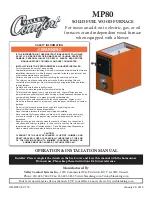
30
COPPER
WIRE ONLY
ELECTRIC
DISCONNECT
SWITCH
ALUMINUM
WIRE
A93033
Fig. 33 -- Disconnect Switch and Furnace
Use a separate, fused branch electrical circuit containing a
properly sized fuse or circuit breaker for this furnace. See Table 6
for wire size and fuse specifications. A disconnecting means must
be located within sight from and readily accessible to furnace.
NOTE
: If polarity is incorrect or the furnace is not grounded,
control LED status indicator light will flash rapidly and furnace
will NOT operate.
FIRE HAZARD
Failure to follow this warning could result in intermittent
operation.
Do not connect aluminum wire between disconnect switch and
furnace. Use only copper wire. (See Fig. 33.)
!
WARNING
ELECTRICAL SHOCK AND FIRE HAZARD
Failure to follow this warning could result in personal injury,
death or property damage.
The furnace casing MUST have an uninterrupted or unbroken
ground according to NEC ANSI/NFPA 70--2008 and Canadian
Electrical Code CSA C22.1 or local codes to minimize
personal injury if an electrical fault should occur. This may
consist of electrical wire or conduit approved for electrical
ground when installed in accordance with existing electrical
codes. Do not use gas piping as an electrical ground.
!
WARNING
Factory Installed J-Box Location
Install electrical entry hole filler plugs (factory-supplied in loose
parts bag) in unused power entry holes. (See Fig. 34.)
J-Box Relocation
1. Remove 2 screws holding auxiliary J-box. (See Fig. 35.)
2. Rotate J-box 180
°
and attach box to left side, using
holes provided.
3. Install electrical entry hole filler plugs (factory-supplied
loose parts Bag) in unused power entry holes. (See Fig.
35.)
ELECTRICAL SHOCK AND FIRE HAZARD
Failure to follow this warning could result in personal injury,
death, or property damage.
If manual disconnect switch is to be mounted on furnace,
select a location where a drill or fastener will not contact
electrical or gas components.
!
WARNING
FACTORY
INSTALLED
LOCATION
UNUSED 7/8-IN. (22 mm)
DIAMETER POWER
ENTRY HOLES
POWER ENTRY HOLE
FILLER PLUG (FACTORY-
SUPPLIED LOOSE PARTS BAG)
A05113
Fig. 34 --
Factory Installed J-Box Location
24-V WIRING
Make field 24-v connections at 24-v terminal block on furnace.
(See Fig. 36.) Connect terminal Y/Y2 as shown in Fig. 31 and 32
for proper cooling operation. Use only AWG No. 18, color-coded,
copper thermostat wire for lengths up to 100 ft. For wire lengths
over 100 ft, use AWG No. 16 wire.
The 24-v circuit contains an automotive-type, 3-amp fuse located
on furnace control. (See Fig. 37.) Any direct shorts of 24-v wiring
during installation, service, or maintenance could cause this fuse
to blow. If fuse replacement is required, use ONLY a 3-amp fuse
of identical size/type. The control will flash code 24 when fuse
needs replacement.
ACCESSORIES
1. Electronic Air Cleaner (EAC) Two male quick-connect
terminals marked EAC-1 and EAC-2 are provided for
EAC connection. (See Fig. 36 or 37.) These terminals are
energized with 115-v (1.0-amp maximum) during blower
motor operation.
2. Humidifier (HUM) Connect an accessory 24 VAC, 0.5
amp maximum humidifier (if used) to the 1/4-in. male
quick-connect HUM terminal and C
OM
-24V screw
terminal on the control board thermostat strip. The HUM
terminal is energized when gas valve is energized. (See
Fig. 36 or 37.)
NOTE
: A field-supplied, 115–v controlled relay connected to
EAC terminals may be added if humidifier operation is desired
during blower operation.
UNIT DAMAGE HAZARD
Failure to follow this caution may result in unit
component damage.
DO NOT connect furnace control HUM terminal to HUM
(humidifier) terminal on Thermidistat
t
, Zone Controller or
similar device. See Thermidistat
t
, Zone Controller,
thermostat, or controller manufacturer’s instructions for
proper connection.
CAUTION
!
Step 9 -- Removal of Existing Furnaces from
Common Vent Systems
When an existing Category I furnace is removed or replaced, the
original venting system may no longer be sized to properly vent
the remaining attached appliances. An improperly sized
Category I venting system could cause the formation of
condensate in the furnace and vent, leakage of condensate and
combustion products, spillage of combustion products into the
living space, etc.
















































